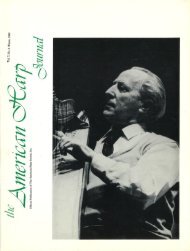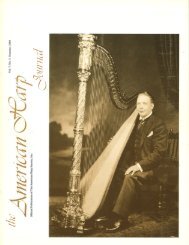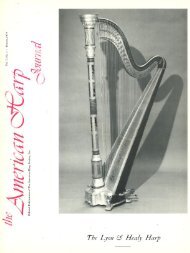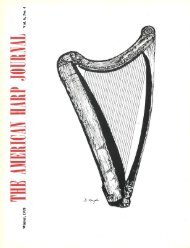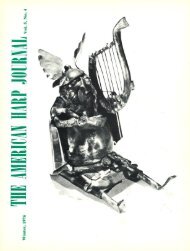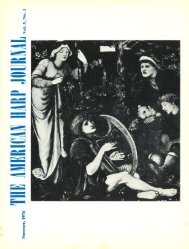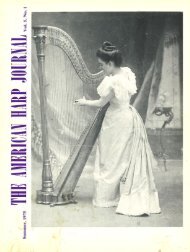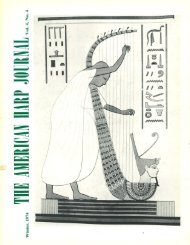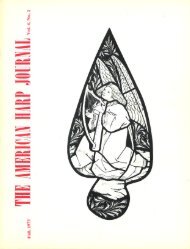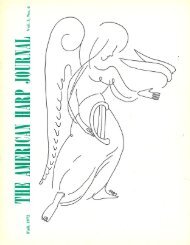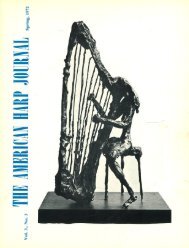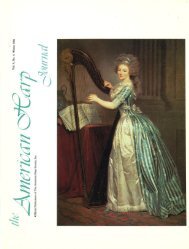AHJ, Vol. 7 No. 1, Summer 1979
AHJ, Vol. 7 No. 1, Summer 1979
AHJ, Vol. 7 No. 1, Summer 1979
Create successful ePaper yourself
Turn your PDF publications into a flip-book with our unique Google optimized e-Paper software.
duced the plays of Yeats, Lady Gregory, John Millington<br />
Synge, Patrick Pearse, Sean O'Casey, George<br />
Bernard Shaw, and a succession of other notable<br />
playwrites.<br />
Irish nationalism finally erupted in rebellion on April<br />
24th, 1916, ignited by the passions of a gentle<br />
schoolmaster, Patrick H. Pearse (1879-1916), author<br />
and martyr of The Easter Proclamation of 1916. The<br />
Proclamation of the Provisional Government of the<br />
Irish Republic, delivered by Pearse under the portico of<br />
the General Post Office in Dublin is the Irish equivalent<br />
of our Declaration of Independence. Within three weeks<br />
all seven signers of The Proclamation were shot.<br />
Ireland rose, but it would be another whole generation,<br />
however, before the Republic of Ireland was proclaimed<br />
on April 18, 1949, severing a bondage of eight hundred<br />
years.<br />
Preservation of the Irish Harp<br />
Looking back, we find that harp playing, although<br />
diminished by the end of the 19th century, was kept<br />
alive in the early years of this century by Catholic nuns.<br />
Two convents in Dublin that have long offered harp instruction<br />
are Loreto Abbey at Rathfranham, and the<br />
Dominican Convent at Sion Hill, Blackrock. In an<br />
earlier article 7 I mentioned the service of Mother Attracta<br />
Coffey of Loreto Abbey in preserving harp playing,<br />
early in this century, and of her successor, Mother<br />
Alphonsus O'Connor, who was the early harp teacher<br />
of Sheila Larchet Cuthbert, now the leading professional<br />
concert harpist in Ireland. Mother Attracta's<br />
published Studied and Irish Harp Tutor (1903) are incorporated<br />
into The Irish Harp Book, edited br Sheila<br />
Cuthbert on behalf of the Irish Harp Society, Cairde na<br />
Cruite, and published in 1975 by Mercier Press.<br />
Musical instruction of all kinds has long been<br />
available at the Royal Irish Academy of Music<br />
(R.I.A.M.), founded in 1856, and now established on<br />
Westland Roy in Dublin. Mrs. Mercedes Bolger Garvey,<br />
a prominent concert harpist, was Professor of Harp for<br />
some years at the R.I.A.M., and is now associated with<br />
the College of Music, Chatham Row, Dublin. The<br />
emblem of the R.I.A.M. is an Irish Harp, surmounted<br />
by a crown, and surrounded with a garland of<br />
shamrock. Anne Crowley, B.Mus., who studied concert<br />
harp with Mercedes Bolger and Maria Korchinska, is<br />
now Professor of Harp, teaching both Irish Harp and<br />
pedal harp at the R.I.A.M. The current Syllabus of examinations<br />
for the Academy lists rigorous requirements<br />
for examination in harp and most other instruments, as<br />
well as orchestra, singing, theory and harmony, speech<br />
training and public speaking.<br />
Other harpists to whom we are indebted for preservation<br />
of the harp, early in this century, were Treasa Ni<br />
Chormaic and Caroline Townsend. Treasa Ni Chormaic,<br />
described by Mrs. Mercedes McGrath Bolger as<br />
the "real descendent of the old Harpers," was taught to<br />
play by her father and had many pupils. Caroline Townsend,<br />
who was an authority on Irish culture, was the<br />
teacher of Mairin and Roisin Ni Sh~ and their sisters.<br />
Mairin Ni Sh~ (Mairin Bean Ui Feirit~ir) recently<br />
SUMMER/<strong>1979</strong><br />
celebrated her Silver Jubilee of teaching Irish Harp and<br />
other subjects at Sion Hill Convent. In over twenty-five<br />
years she has taught hundreds of harpists to play and<br />
sing with the harp, and prepares young harpist-singers<br />
who perform for delighted guests at Jury's Hotel in<br />
Dublin and elsewhere. A graduate of the University College<br />
Dublin, (U.C.D.) she studied voice and piano at the<br />
Royal Irish Academy of Music, and harp with Miss<br />
Townsend, and has performed widely, representing<br />
Ireland in Celtic countries and in the United States. A<br />
revival of interest in the Irish Harp can be traced to An<br />
T~stal (cultural festival) of 1953, when Mairin Ni Sh~<br />
presented several of her pupils in performance. These<br />
were Mary O'Hara, Dierdre Ni Fhlionn, and Kathleen<br />
Watkins. They were invited to take part in the celebrations·<br />
in London and to perform on BBC Radio and<br />
Television, at which time Mairin lectured in London on<br />
the subject of Irish Harp. This was received with enthusiasm<br />
and the performers were soon very much in demand.<br />
Mairin's husband, Michaeal Feiriteir, teaches Classics<br />
at Castleknock College, and both are dedicated to Irish<br />
culture and language. (This might be the occasion to<br />
point out that Irish women frequently use their maiden<br />
names, though married. The form Ni preceding the<br />
maiden or parental name means "daughter of", while<br />
the form Bean ui, followed by the husband's surname<br />
means, literally, "woman of" or "wife of". Mairin<br />
might also be addressed, in English, by her pupils for_instance,<br />
as "Mrs; J;erriter. ") I had th,e pleasure o~<br />
meeting both Mairin and her sister Raisin Bean Ui<br />
Thuama on my recent visit to Dublin. Mairin and her<br />
pupils at Sion Hill entertained me with singing to thefr<br />
own accompaniment on Irish Harp in the style made<br />
famous by her illustrious former pupil, Mary O'Hara.<br />
Roisin Ni Sh~, also a graduate of U.C.D., has also<br />
performed widely as an Irish Traditional Singer and<br />
singing to her own harp accompaniment, on Radio and<br />
Television, as well as for An Oireachtas (Irish language<br />
festival), and at the Celtic Congresses. Roisin and her<br />
husband S~amus O Thuama, have a large, musical family.<br />
They entertained me graciously in their home with<br />
Roisin singing and playing traditional airs on her<br />
original MacFall harp while her son accompanied his<br />
mother with the flute.<br />
It was also my pleasure on my recent trip to Dublin to<br />
meet Miss Nancy Calthorpe, a prominent musician,<br />
teacher, and composer. A native of Waterford, she<br />
comes from a family of professional musicians<br />
associated with the musical life of Waterford for over a<br />
century. From a very early age she studied music, first in<br />
Ireland, and later in London and the Continent. She<br />
holds the Licentiate Diploma of the Royal Academy of<br />
Music, London (teacher of Singing) and the Licentiate<br />
Diploma of the Trinity College of Music, London<br />
(teacher of Pianoforte). She studied Singing and Irish<br />
Harp under Sheila Larchet Cuthbert and Mairin N{ Sh~.<br />
She has taught at Loreto Abbey and Sion Hill and is<br />
now on the Teaching Staff of the Dublin Municipal College<br />
of Music, Catham Row, just off Grafton Street in<br />
the center of Dublin. She teaches Harmony, Theory,<br />
33




